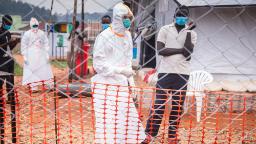[ad_1]

Editor’s Note: Dr. Tom Frieden, director of the CDC from 2009-2017, oversaw responses to the H1N1 influenza, Ebola and Zika epidemics, is President and CEO of Resolve to Save Lives, and Senior Fellow for Global Health at the Council on Foreign Relations.
Precious Matsoso is the former Director-General of the South African National Department of Health and was the World Health Organisation Director of Public Health Innovation and Intellectual Property. Precious Matsoso is currently the Director of the Health Regulatory Science Platform, a division of the Wits Health Consortium and an Honorary Lecturer in the Department of Pharmacy and Pharmacology, University of the Witwatersrand.
CNN
—
In late June of this year, Ghana’s health authorities received some disturbing news: Two cases of viral hemorrhagic fever were detected in the country. Blood samples from the infected individuals came back positive for Marburg virus, a deadly disease that can kill most of those infected.
The outbreak triggered emergency response efforts across all levels of government in Ghana. Nearly 200 contacts were identified and interviewed. Health care workers were reminded how to keep themselves and their patients safe from Marburg infection. Volunteers in the community with no medical background were trained to recognize signs of the disease, refer people with suspected Marburg infection to the appropriate authorities and deliver information to the community to help reduce disease threats.
Following these efforts, no further cases were detected. After a conservative waiting period, the outbreak was declared over on September 16.
Why didn’t this story make headlines? Because it was an epidemic that didn’t happen.
The public and the media tend to focus on what’s going wrong: Covid-19, monkeypox, polio, and now Ebola. But this focus obscures what is happening on the ground, every day: Local and national public health workers and epidemiologists, or “disease detectives,” around the world are stopping outbreaks in their tracks and preventing epidemics.
To celebrate these efforts, Resolve to Save Lives has issued its second report on “Epidemics That Didn’t Happen.” The new report details six outbreaks that were stopped in 2021 – stories that otherwise would not make headlines but that offer valuable insights into what public health can and does do right. The case studies show what is possible when local, state and national communities mobilize a whole-of-society effort to prevent epidemics.
One lesson that stands out is that, because outbreaks begin and end in communities, well-coordinated action at the local level is crucial. Rabies is nearly always fatal, and after one tragic case in Tanzania, public health workers joined with community leaders to make sure that every other exposed person received the vaccine, saving lives. Without sensitive community engagement, more children would have died. When local efforts are supported by national and local government, we can stop and prevent epidemics.
Another lesson is the substantial return on investment we can realize by prioritizing and funding preparedness efforts. The 2014-16 West Africa Ebola outbreak claimed more than 11,000 lives and cost the global economy an estimated $53 billion. To prevent another devastating loss of lives and livelihoods, Guinea coordinated substantial improvements to its health security at national and subnational levels. It established the National Agency for Health Security and one national and 38 district-level emergency operation centers. The country also hired and trained public health doctors and others in outbreak response. Then, when an Ebola outbreak emerged in January 2021, the country was ready to coordinate a strong response. The outbreak was declared over with just 23 cases because Guinea made sustained investments to prepare for the next health threat.
Finally, there is a crucial role that coordination among local, state and federal agencies plays in epidemic prevention. Following an outbreak of Nipah virus in Kerala, India in 2018 that saw 18 cases – 17 of which were fatal – state officials identified gaps in response efforts and improved them. When a case was identified in the state in 2021, officials across local, district, state and national bodies immediately convened to plan and execute response measures. Within days, officials identified 240 contacts, tested fruit bats (reservoirs of the virus) in the affected area and conducted a risk communication campaign with the public. This outbreak began and ended with just the single index case.
These case studies demonstrate what can happen – and what won’t happen – when countries invest in and prioritize preparedness so they are ready to act quickly and strategically when outbreaks strike. Offering a preview of what a public health renaissance could look like, they show what is possible when all levels of society work together to maintain a resilient health system built on pillars of community trust and equity.
These are important lessons as we continue to strengthen preparedness in the face of new diseases and as the World Health Organization considers a global pandemic treaty instrument to make our world better prepared. A pandemic treaty instrument that is driven by this country- and community-first experience and vision, and built on principles of solidarity and equity, has the potential to help countries greatly improve their preparedness for the next disease threat. And as our new report shows – preparedness is not only possible, it’s happening every day. To protect us all, the global community must consistently invest in preparedness and prioritize it with political and financial resources.
Source link



